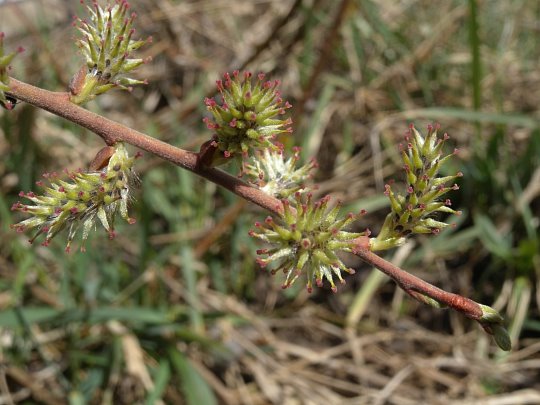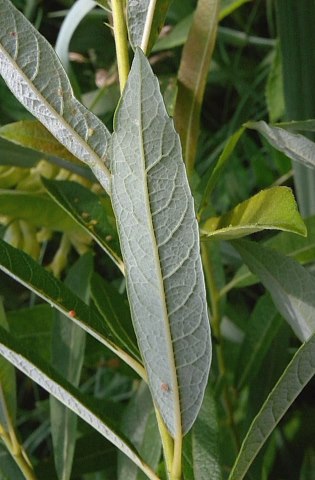
Prairie Willow is dioecious, producing either all male (staminate) or all female (pistillate) catkins on separate shrubs. Male catkins are ¼-¾" long, consisting of numerous male florets. Initially, male catkins are fuzzy and gray, but they later become more red or yellow from the anthers of their stamens. Each male floret consists of 2 stamens and a silky-hairy bract about 1.5-2.0 mm. in length. The female catkins are ½-2" long, consisting of numerous female florets. Initially, female catkins are somewhat fuzzy and gray, but they later become green, and finally light brown. Each female floret consists of a lanceoloid pistil about 4-8 mm. in length and a silky-hairy bract about 1.5-2.0 mm. in length. There are short pedicels underneath the female florets. The blooming period occurs from early to mid-spring for about 1 week. Afterwards, during late spring or early summer, fertile female florets are transformed into seed capsules that split open at maturity to release their seeds. The tiny seeds are embedded in cottony hairs; they are distributed by the wind. The woody root system is shallow and branching. This shrub reproduces by reseeding itself.
 Cultivation:
The preference is full or partial sun, moist to dry-mesic conditions,
and soil that is loamy or sandy. Most growth and develop occurs from
spring to mid-summer. The tiny seeds remain viable for about 1-2 weeks.
A
new clonal shrub can be created by cutting a branchlet from an older
shrub during the early spring and sticking the cut-end of this
branchlet into moist ground.
Cultivation:
The preference is full or partial sun, moist to dry-mesic conditions,
and soil that is loamy or sandy. Most growth and develop occurs from
spring to mid-summer. The tiny seeds remain viable for about 1-2 weeks.
A
new clonal shrub can be created by cutting a branchlet from an older
shrub during the early spring and sticking the cut-end of this
branchlet into moist ground.Range and Habitat: The native Smooth Prairie Willow is relatively uncommon in Illinois, where it is found in widely scattered counties (see Distribution Map). Habitats include moist to mesic prairies, moist to mesic sand prairies, willow thickets, sandy and non-sandy savannas, bases of sandstone bluffs, and sedge meadows. This shrub adapts to both well-drained upland areas and poorly drained bottomland areas.
Faunal Associations: The florets of the catkins are cross-pollinated by insects. These floral visitors include Cuckoo bees (Nomada spp.), Andrenid bees (Andrena spp.), Halictid bees (Halictus spp., Lasioglossum spp.), sawflies (Dolerus spp.), Syrphid flies, miscellaneous beetles, and other insects. Andrenid bees that are specialist pollinators (oligoleges) of willows (Salix spp.) include Andrena bisalicis, Andrena erythrogaster, Andrena fenningeri, Andrena illinoiensis, Andrena mariae, and Andrena salictaria. Smooth Prairie Willow and other willows are host plants to a variety of insects that feed on their leaves, bore through their branchlets, or suck plant juices. These species include the leafhoppers Empoasca andresia, Empoasca humilis, and Erythroneura rosa; Aphis salicariae (Willow Aphid), Cavariella aegopodii (Carrot-Willow Aphid), Chaitophorus viminalis (Small Black & Green Willow Aphid), and Tuberolachnus salignus (Giant Willow Aphid); Lopidea salicis (Willow Plant Bug) and other plant bugs; the leaf beetles Chrysomela knabi, Chrysomela lineatopunctata, Chrysomela scripta, Crepidodera decora, Crepidodera nana, Cryptocephalus leucomelas, and Disonycha alternata; Rhynchaenus rufipes (Willow Flea Weevil); the wood-boring larvae of Agrilus politus (Common Willow Agrilus); larvae of the gall flies Dasineura salicifolia and Asphondylia salictaria; larvae of Nematus ventralis (Willow Sawfly), Pontania proxima (Willow Redgall Sawfly), and Pontania s-pomum (Willow Gall Sawfly); and Diapheromera velii (Prairie Walkingstick). Some vertebrate animals use willows as a source of food and protective cover. The buds are eaten by the Ruffed Grouse, while the catkins are eaten by the White-Crowned Sparrow. Such birds as the Yellow Warbler, Warbling Vireo, and Yellow-Breasted Chat use these shrubs for protective cover and nesting habitat. The twigs and foliage are browsed occasionally by the White-Tailed Deer and Cottontail Rabbit.

Photographic Location: A wildflower garden in Urbana, Illinois.
Comments: Some authorities don't recognize Smooth Prairie Willow as a distinct variety of Prairie Willow, although Mohlenbrock (2002) does. Smooth Prairie Willow is very similar to the typical variety of Prairie Willow, except that its leaves are hairless, or nearly so. Smooth Prairie Willow resembles the native Salix discolor (Pussy Willow), except that its leaves and stipules are more narrow than those of the latter. Another variety of Prairie Willow, Salix humilis microphylla (Sage Willow), is a shrub about 1-3' tall that has smaller leaves and smaller catkins. This latter variety prefers dry open areas; it is relatively uncommon in Illinois.